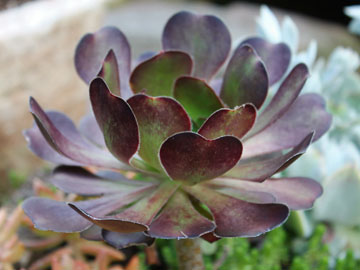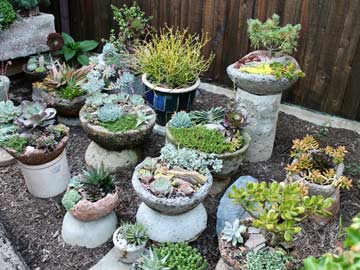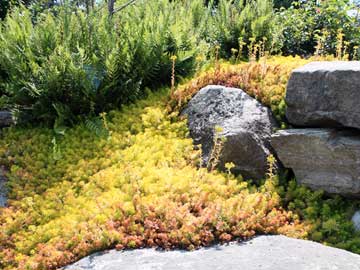 Red salad bowl is a succulent with dark-burgundy fleshy leaves and a leaf pattern similar to a rose.
Red salad bowl is a succulent with dark-burgundy fleshy leaves and a leaf pattern similar to a rose.
© George Weigel
No wonder succulents are catching on. They’re compact, versatile, colorful, and easy to grow. They’re also not prone to bugs or disease, they need no spraying, need little water or fertilizer, and even the deer and bunnies let them alone. In short, they’re about as low-care and hardy plants as you’re going to find. So what are these wonder plants?
Unlike hydrangeas or roses, succulents aren’t a related family of plants but rather a loosely defined type of plant with similar characteristics – specifically, ones with fleshy foliage or bulbous stems that give them the ability to survive dry conditions. Think species such as cactus, aloe, sedum and the old-fashioned favorite “hens and chicks” (a type of sempervivum). Such plants have evolved in arid spots all over the globe – everywhere except Antarctica.
They’ve become increasingly popular in recent years, especially as reluctant, newbie and/or low-care-seeking gardeners discover their merits and ready availability, including at big box stores. Succulents are naturals for rock gardens, but most of them do well lining hot driveways or covering the ground on sunny slopes.
 All sorts of compact succulents make ideal container plants that don’t have to be watered as often as flowers.
All sorts of compact succulents make ideal container plants that don’t have to be watered as often as flowers.
© George Weigel
The recent wave of interest finds them as container favorites – less-fussy and hard-to-kill alternatives to annual flowers in pots, window boxes and hanging baskets. The big advantage in pots is that succulents don’t need the daily watering that flowers do.
Succulents are even showing up as favors these days on wedding tables. And they’re interesting enough that they’re as attractive to experienced plant geeks as they are to beginner gardeners.
If you’re going to kill a succulent, it’s usually from too much TLC – i.e. too much water. Don’t water succulents too often or too much, and make sure your containers have drainage holes in the bottom. Soggy soil is the kiss of death to most succulents. Teacups, mason jars, toy trucks and similar containers that don’t have drainage holes might look cute, but they’re also more likely to kill a succulent than a container with ample drainage holes. A good rule of thumb: soak them when the soil goes dry, then let them alone until the soil dries again.
In a pot, that might equate to once every 5 to 7 days in summer. In the ground, a succulent usually survives without any supplemental watering. Remember, succulents DO need water. They just don’t need it as often as most plants. Also important is using a well drained potting medium for container-grown succulents in the first place. Use a “gritty mix” that’s a blend of bark fines, chicken grit and mineral fragments, such as calcinated or baked clay fragments. Some succulent growers use aquarium soil or a bagged soil conditioner with grit in the mix. Easier still is buying bags of cactus mix instead of standard potting soil or potting mix.
Most succulents are light feeders as well as light drinkers. In a pot, a gradual-release fertilizer at planting is usually plenty to get these plants off to the right start.
 This patch of golden creeping sedum 'Angelina' makes a durable rock-garden groundcover.
This patch of golden creeping sedum 'Angelina' makes a durable rock-garden groundcover.
© George Weigel
Succulents in the ground usually need no supplemental fertilizer. Another benefit to succulents is that most of them are easy to propagate. Many send out babies (also called “offsets” or “pups”) that can be dug, broken off and planted on their own – even without roots. Others will root from tip cuttings, and some will grow roots from pinched-off leaves that are simply set on top of the same gritty mix used to grow potted succulents.
One other important thing to know about succulents is that some of them are cold-hardier than others. Some withstand below-freezing weather (perennials in the North), while others are tropicals that need to go inside during cold winters or treated as annuals. Hens and chicks (Sempervivum arachnoideum), ice plant (Delosperma) and most creeping sedums are winter-hardy succulents.
Interesting non-freeze-hardy succulents include red salad bowl (Aeonium urbicum rubrum), black tree aeonium ‘Swartkop,’ paddle plant (Kalanchoe luciae), jelly bean plant (Sedum rubrotinctum), jade plant (Crassula ovata), string of pearls (Senecio rowleyanus), blue chalk sticks (Senecio mandraliscae), and just about any echeveria, aloe, cactus, euphorbia or graptopetalum.